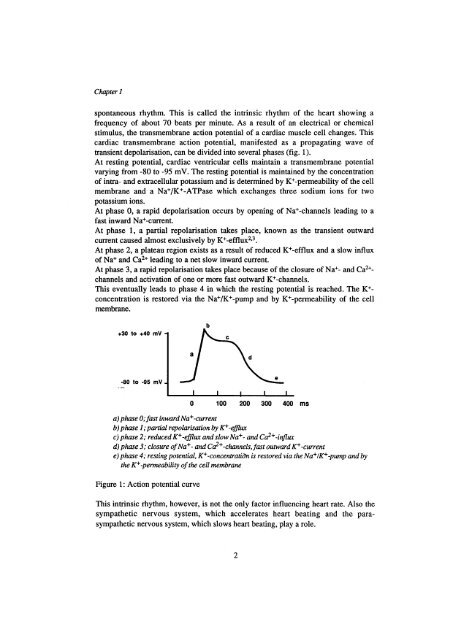synthesis and in vitro pharmacology of a series of histamine h2 ...
synthesis and in vitro pharmacology of a series of histamine h2 ...
synthesis and in vitro pharmacology of a series of histamine h2 ...
Create successful ePaper yourself
Turn your PDF publications into a flip-book with our unique Google optimized e-Paper software.
Chapter 1<br />
spontaneous rhythm. This is called the <strong>in</strong>tr<strong>in</strong>sic rhythm <strong>of</strong> the heart show<strong>in</strong>g a<br />
frequency <strong>of</strong> about 70 beats per m<strong>in</strong>ute. As a result <strong>of</strong> an electrical or chemical<br />
stimulus, the transmembrane action potential <strong>of</strong> a cardiac muscle cell changes. This<br />
cardiac transmembrane action potential, manifested as a propagat<strong>in</strong>g wave <strong>of</strong><br />
transient depolarisation, can be divided <strong>in</strong>to several phases (fig. 1).<br />
At rest<strong>in</strong>g potential, cardiac ventricular cells ma<strong>in</strong>ta<strong>in</strong> a transmembrane potential<br />
vary<strong>in</strong>g from -80 to -95 mV. The rest<strong>in</strong>g potential is ma<strong>in</strong>ta<strong>in</strong>ed by the concentration<br />
<strong>of</strong> <strong>in</strong>tra- <strong>and</strong> extracellular potassium <strong>and</strong> is determ<strong>in</strong>ed by K +<br />
-permeability <strong>of</strong> the cell<br />
membrane <strong>and</strong> a Na +<br />
/K +<br />
-ATPase which exchanges three sodium ions for two<br />
potassium ions.<br />
At phase 0, a rapid depolarisation occurs by open<strong>in</strong>g <strong>of</strong> Na +<br />
-channels lead<strong>in</strong>g to a<br />
fast <strong>in</strong>ward Na +<br />
-current.<br />
At phase 1, a partial repolarisation takes place, known as the transient outward<br />
current caused almost exclusively by K +<br />
-efflux 2<br />
' 3<br />
.<br />
At phase 2, a plateau region exists as a result <strong>of</strong> reduced K +<br />
-efflux <strong>and</strong> a slow <strong>in</strong>flux<br />
<strong>of</strong> Na +<br />
2 +<br />
<strong>and</strong> Ca lead<strong>in</strong>g to a net slow <strong>in</strong>ward current.<br />
At phase 3, a rapid repolarisation takes place because <strong>of</strong> the closure <strong>of</strong> Na +<br />
- <strong>and</strong> Ca 2+<br />
-<br />
channels <strong>and</strong> activation <strong>of</strong> one or more fast outward K +<br />
-channels.<br />
This eventually leads to phase 4 <strong>in</strong> which the rest<strong>in</strong>g potential is reached. The K +<br />
-<br />
concentration is restored via the Na +<br />
/K +<br />
-pump <strong>and</strong> by K +<br />
-permeability <strong>of</strong> the cell<br />
membrane.<br />
+30 to +40 mV<br />
•80 to -95 mV<br />
b<br />
0 100 200 300 400 ms<br />
a) phase 0;fast <strong>in</strong>ward Na+-current<br />
b) phase 1; partial repolarisation by K+-efflux<br />
c) phase 2; reduced K+-efflux <strong>and</strong> slow Na +<br />
- <strong>and</strong> Ca 2<br />
* -<strong>in</strong>flux<br />
d) phase 3; closure <strong>of</strong>Na+- <strong>and</strong> Ca*+-channels, fast outward K +<br />
-current<br />
e) phase 4; rest<strong>in</strong>g potential, K+-concentration is restored via the Na+IK+-pump <strong>and</strong> by<br />
the K+-permeability <strong>of</strong> the cell membrane<br />
Figure 1: Action potential curve<br />
This <strong>in</strong>tr<strong>in</strong>sic rhythm, however, is not the only factor <strong>in</strong>fluenc<strong>in</strong>g heart rate. Also the<br />
sympathetic nervous system, which accelerates heart beat<strong>in</strong>g <strong>and</strong> the para<br />
sympathetic nervous system, which slows heart beat<strong>in</strong>g, play a role.<br />
2

















